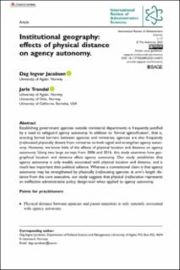Abstract
Establishing government agencies outside ministerial departments is frequently justified by a need to safeguard agency autonomy. In addition to ‘formal agencification’, that is, erecting formal barriers between agencies and ministries, agencies are also frequently (re)located physically distant from ministries to both signal and strengthen agency autonomy. However, we know little of the effects of physical location and distance on agency autonomy. Using two large surveys from 2006 and 2016, this study examines how geographical location and distance affect agency autonomy. Our study establishes that agency autonomy is only weakly associated with physical location and distance, and is much less important than political salience. Whereas a conventional claim is that agency autonomy may be strengthened by physically (re)locating agencies at arm's length distance from the core executive, our study suggests that physical (re)location represents an ineffective administrative policy design-tool when applied to agency autonomy.
Full info
Dag Ingvar Jacobsen og Jarle Trondal
Institutional geography: effects of physical distance on agency autonomy
International Review of Administrative Sciences, 2024.
